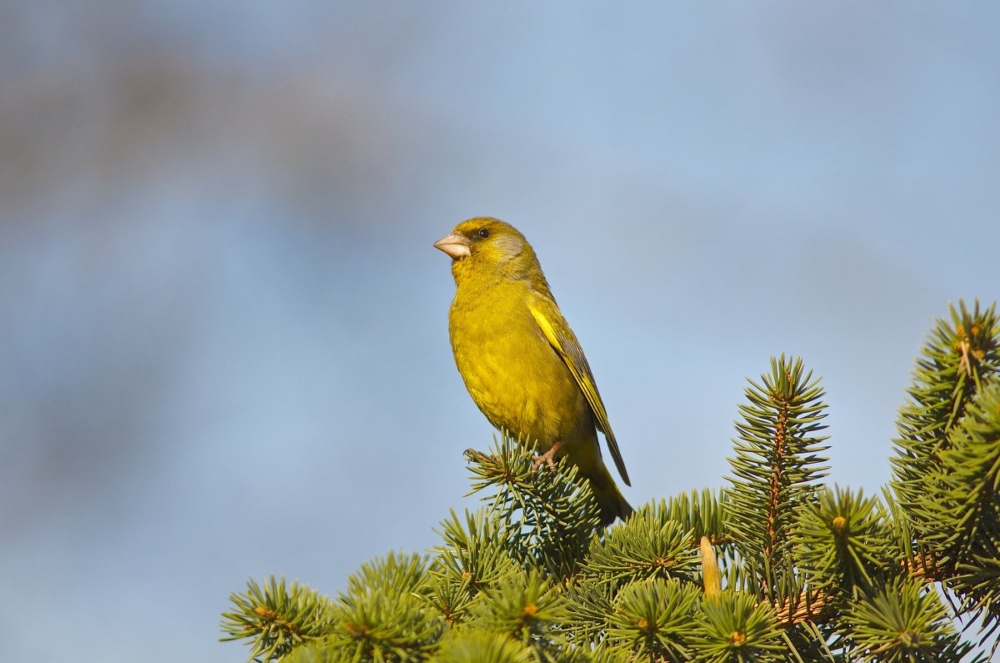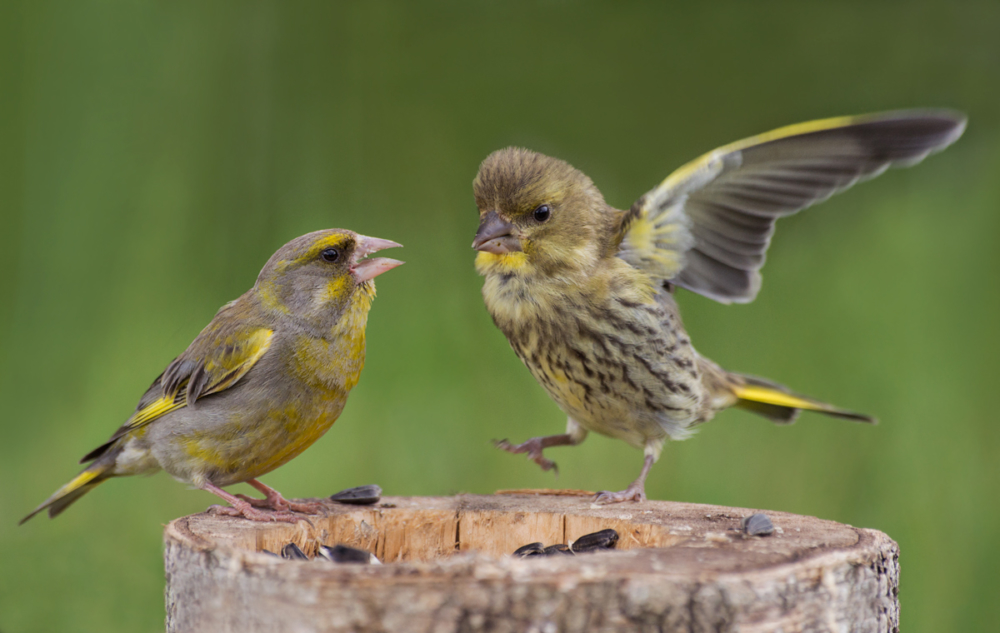The common greenfinch is a small bird known for its sonorous singing and friendly disposition.
She can be found in forests and parks, squares and gardens, where she loudly announces the arrival of the first warm days and the beginning of a new mating season.
Material Content:
Description of common greenfinch
Ordinary green or oak-moss, as it was called in antiquity, is a representative of the Vyurkov family and, like most of the finch, is small in size. She is slightly superior to the sparrow and looks like him in physique.
A description of the species Carduelis chloris can begin with the fact that this feathered creature has a short neck, a dense body and a small tail with a notch in the middle. The plumage is painted in a brown-olive color, which becomes lighter in the lower abdomen and on the back under the wings. The chest has a more saturated greenish-yellow hue. There are bright yellow stripes on the wings and on the edges of the tail.
The bird has a large cone-shaped beak, wide at the base, which it uses to crack grains and seeds. The eyes look like shiny black beads, the cheeks and tail are gray. Females are usually less brightly colored than males.
Lifestyle and behavior
Zelenushka leads a daily lifestyle and is a conditionally migratory species. In warmer regions, it does not leave its homes, while in cold regions it can fly away for the winter. The distances covered by birds during the period of seasonal migration are not very large. Therefore, in early spring, forest canaries, as these birds are also called, are among the first to return to their usual habitats.
They move in small flocks, accompanying their appearance with loud twittering.The ranks are calm and non-conflict. They rarely enter into skirmishes and do not pose a threat to other species.
It is interesting! The flight of these little creatures is noteworthy. The trajectory they describe in the air is similar to that characteristic of bats. In addition, birds are able to make a variety of pirouettes and swiftly dive from top to bottom, having done before this several circles.
Habitat, habitat
The natural habitat of greenfinches is North Africa and Eurasia. Artificially, they were settled in Australia and South America. In the wild, birds prefer landscapes where there is woody vegetation or a bush with a dense crown. They avoid dense dark forests by choosing well-ventilated edges and clearings. Near cities they like to settle in overgrown gardens and old parks. Often you can meet them near rural areas where birds feed on the gifts of the fields.
Diet greenfinch
The ranks are omnivores, but most of their diets are plant foods. They consume seeds, grains, berries, buds, plant sprouts. Large seeds are processed for a long time in the beak and only after they are released from the hard shell, are swallowed.
Birds have a good appetite. One of the favorite treats is the juniper fruit. Insects get to their menu only occasionally and in small quantities. It can be flies, larvae, small bugs. In captivity, they are fed a canary mixture, weed seeds, canola, sorghum.
Breeding and offspring
The greenfinch bird begins to care about procreation with the advent of spring. Most of the hassle of creating a nest is assumed by the female. She also carries out incubation independently. The male’s contribution to the reproductive process is limited to fertilization and providing the female with food while she sits on the eggs. After the chicks hatch, both parents get food for their offspring.
The offspring are growing rapidly and within 2 weeks they are ready to leave their home. The first week after departure from the nest, parents feed the chicks, and then provide them with the opportunity to search for food themselves. After the first brood switched to independent feeding, the male and female begin to build a new nest and again masonry. Under good conditions, reproduction occurs 2-3 times per season.
Bird singing
Carduelis chloris is often kept in the house as songbirds. These cute creatures have an iridescent sonorous voice, their singing is pleasant and varied. It consists of chirps and trills, interspersed with the characteristic sound of those birds, “shrize-e-euuu” or “dzhu-u-ii”. The rolling trill, which the ranks withdraw, seems to consist of small beads rolling in their neck with a resounding tapping. Singing greenfinch is especially often heard in April and May, but it continues throughout the summer.
Feathered do not abandon their songs in captivity. They begin to twitter in the apartment in January-March and, under good conditions of detention, often delight the owner with vigorous overflows. Observation of this bird and communication with it, of course, can raise the spirits and bring joyful revival to boring gray everyday life.
















